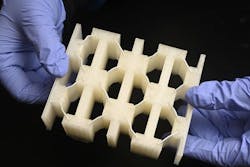A team of Johns Hopkins University researchers created a shock-absorbing material that protects like a metal, but is lighter, stronger and reusable. The new foam-like material could be a game-changer for helmets, body armor and automobile and aerospace parts. The team wanted to create a material even more energy-absorbing than current car bumpers and helmet padding. The researchers noticed that typical materials used for protective devices don’t perform well at higher speeds and often aren’t reusable.
The team increased the foam-like material’s ability to withstand impacts by adding high-energy-absorbing liquid crystal elastomers, which have been used mainly in actuators and robotics.
During testing, the new recyclable material held up against strikes from objects weighing about 4 to 15 lb traveling up to 22 mph. The team is confident the padding could safely absorb even greater impacts.
“We are excited about our findings on the extreme energy absorption capability of the new material,” says JHU researcher Sung Hoon Kang, an assistant professor of mechanical engineering. “The material offers more protection from a wide range of impacts but being lighter could reduce fuel consumption and the environmental impact of vehicles while being more comfortable for those wearing protective gears.”
Kang and his team are exploring a collaboration with a helmet company to design, fabricate and test next-generation helmets for athletes and the military.
